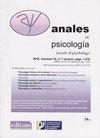The role of affect in pacing: experimental study
IF 1.3
4区 心理学
Q3 PSYCHOLOGY
引用次数: 0
Abstract
People with chronic pain often change the way they carry out their daily activities according to different patterns, among which are pacing strategies. Cross-sectional studies on the association between pacing and affect show contradictory results. The study aim was to experimentally test whether the induction of positive affect vs negative affect would influence the choice of the type of pacing (pacing to increase productivity or pacing to reduce pain) when the participants were exposed to pain, while controlling for the variables optimism and catastrophism. The study participants comprised a sample of 145 undergraduates. The results of multinomial logistic regression showed that there was no association between the variables. Pacing is an intervention strategy in all chronic pain intervention models, and thus it is relevant to continue investigating the role of affect in relation to pacing. Las personas con dolor crónico cambian la forma de realizar las actividades cotidianas, diferenciándose diversos patrones, entre ellos, la secuenciación de actividades (pacing). La bibliografía acerca de la relación entre pacing y afecto muestran resultados contradictorios. El objetivo de este estudio fue contrastar experimentalmente, en una muestra de 145 estudiantes, si la inducción de afecto positivo vs negativo influía en la elección del tipo de “pacing” (“pacing para aumentar la productividad” y “pacing para reducir el dolor”) cuando los participantes eran expuestos a dolor, controlando las variables optimismo y catastrofismo. Los resultados de la regresión logística multinomial no mostraron relación entre las variables. El pacing es una estrategia de intervención presente en todos los modelos de intervención en dolor crónico y, por tanto, es relevante seguir profundizando acerca del rol del afecto en relación al mismo.情感在起搏中的作用:实验研究
患有慢性疼痛的人往往会根据不同的模式改变他们开展日常活动的方式,其中包括缓解策略。关于和平与情感之间联系的跨部门研究显示出矛盾的结果。这项研究的目的是通过实验测试,在控制变量乐观主义和灾难主义的同时,积极影响与消极影响的诱导是否会影响参与者接触痛苦时对和平类型(提高生产力或减少痛苦)的选择。研究参与者包括145名大学生的样本。多项式Logistic回归结果表明,变量之间没有相关性。起搏是所有慢性疼痛干预模型中的一种干预策略,因此,继续研究情感在起搏中的作用是相关的。患有慢性疼痛的人改变了日常活动的方式,区分了各种模式,包括活动顺序(PACING)。关于和平与感情之间关系的文献显示了相互矛盾的结果。这项研究的目的是在145名学生的样本中进行实验对比,通过控制乐观和灾难性变量,在参与者暴露于痛苦时,积极和消极情感的诱导是否会影响“和平”类型的选择。多项Logistic回归结果显示变量之间没有关系。起搏是所有慢性疼痛干预模型中都存在的一种干预策略,因此,有必要继续深入研究情感在慢性疼痛中的作用。
本文章由计算机程序翻译,如有差异,请以英文原文为准。
求助全文
约1分钟内获得全文
求助全文
来源期刊

Anales De Psicologia
医学-心理学
CiteScore
3.30
自引率
5.90%
发文量
57
审稿时长
4-8 weeks
期刊介绍:
Anales de Psicologia / Annals of Psychology is a multidisciplinary journal of the various thematic areas of scientific psychology. It publishes original research articles and theoretical review in any of its basic, applied and methodological areas included within psychology.
Publishing, financing, marketing and distribution corresponds Editum: Editions of the University of Murcia (Spain). The organizational guidelines and editorial policies come from the Editorial Team (elected for four years by the Areas and / or Departments of Psychology at the University of Murcia) and the Editorial Board, composed of scholars and experts from different universities and institutions national and international. It is published in print (ISSN: 0212-9728) since 1984 and in Internet publishing (web) (ISSN: 1695-2294) since 2000. Available online full text in pdf from the vol. 1 1984.
Anales de Psicologia / Annals of Psychology maintains a system of exchange with other journals and publications of psychology in the world. Through an free exchange agreement with their respective publishers or entities responsible for editing, these journals and publications are received at the University of Murcia (Biblioteca "Luis Vives", near the Faculty of Psychology) and in return, our journal is sent to libraries and educational and research institutions such centers responsible for editing.
 求助内容:
求助内容: 应助结果提醒方式:
应助结果提醒方式:


